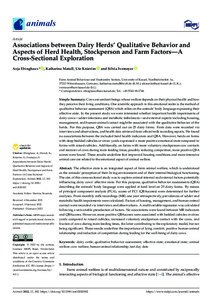| dc.date.accessioned | 2022-05-06T08:09:52Z | |
| dc.date.available | 2022-05-06T08:09:52Z | |
| dc.date.issued | 2022-01-22 | |
| dc.identifier | doi:10.17170/kobra-202205066143 | |
| dc.identifier.uri | http://hdl.handle.net/123456789/13815 | |
| dc.description.sponsorship | Gefördert durch den Publikationsfonds der Universität Kassel | |
| dc.language.iso | eng | |
| dc.rights | Namensnennung 4.0 International | * |
| dc.rights.uri | http://creativecommons.org/licenses/by/4.0/ | * |
| dc.subject | dairy cattle | eng |
| dc.subject | qualitative behavior assessment | eng |
| dc.subject | affective state | eng |
| dc.subject | emotional state | eng |
| dc.subject | animal welfare | eng |
| dc.subject | cow welfare | eng |
| dc.subject | human-animal relationship | eng |
| dc.subject | test day data | eng |
| dc.subject.ddc | 630 | |
| dc.title | Associations between Dairy Herds’ Qualitative Behavior and Aspects of Herd Health, Stockperson and Farm Factors—A Cross-Sectional Exploration | eng |
| dc.type | Aufsatz | |
| dcterms.abstract | The affective state is an integrated aspect of farm animal welfare, which is understood as the animals’ perception of their living environment and of their internal biological functioning. The aim of this cross-sectional study was to explore animal-internal and external factors potentially influencing dairy cows’ affective state. For this purpose, qualitative behavior assessments (QBA) describing the animals’ body language were applied at herd level on 25 dairy farms. By means of principal component analysis (PCA), scores of PC1 (QBAscores) were determined for further analyses. From monthly milk recordings (MR) one year retrospectively, prevalences of udder and metabolic health impairments were calculated. Factors of housing, management, and human-animal contact were recorded via interviews and observations. A multivariable regression was calculated following a univariable preselection of factors. No associations were found between MR indicators and QBAscores. However, more positive QBAscores were associated with bedded cubicles or straw yards compared to raised cubicles, increased voluntary stockperson contact with the cows, and fixation of cows during main feeding times, the latter contributing to the explanatory model, but not being significant. These results underline the importance of lying comfort, positive human-animal relationship and reduction of competition during feeding for the well-being of dairy cows. | eng |
| dcterms.accessRights | open access | |
| dcterms.creator | Ebinghaus, Asja | |
| dcterms.creator | Matull, Katharina | |
| dcterms.creator | Knierim, Ute | |
| dcterms.creator | Ivemeyer, Silvia | |
| dc.relation.doi | doi:10.3390/ani12020182 | |
| dc.subject.swd | Milchvieh | ger |
| dc.subject.swd | Tiergesundheit | ger |
| dc.subject.swd | Verhaltensbeurteilung | ger |
| dc.subject.swd | Mentaler Zustand | ger |
| dc.subject.swd | Mensch-Tier-Beziehung | ger |
| dc.type.version | publishedVersion | |
| dcterms.source.identifier | eissn:2076-2615 | |
| dcterms.source.issue | Issue 2 | |
| dcterms.source.journal | Animals | eng |
| dcterms.source.volume | Volumme 12 | |
| kup.iskup | false | |
| dcterms.source.articlenumber | 0182 | |


